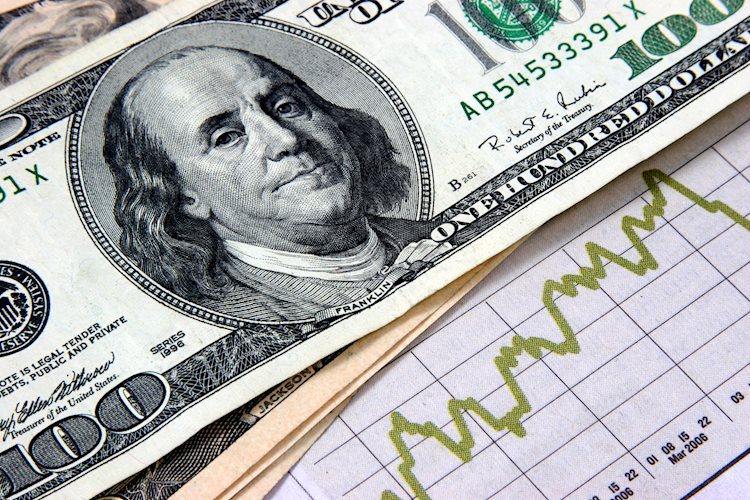- US Dollar has lost its strength in the American session on Monday.
- US Dollar Index erased its daily gains and returned to the 104.00 area.
- ISM Services PMI report for May showed a loss of momentum in the service sector.
The US Dollar (USD) has lost its strength in the second half of the day on Monday. The US Dollar Index (DXY), which tracks the USD’s valuation against a basket of six major currencies, reversed its direction and retreated to the 104.00 area after having climbed toward 104.50 earlier in the day.
The monthly data published by the ISM showed that the business activity in the US service sector continued to expand in May, albeit at a softer pace than it did in April. The ISM Services PMI declined to 50.3 in May from 51.9 in April and missed the market expectation of 51.5.
Daily digest market movers: US Dollar finds its footing
- Further details of the ISM PMI report revealed that the Prices Paid Index edged lower to 56.2 from 59.6 and the Employment Index dropped to 49.2 from 50.8.
- Commenting on the data, “there has been a pullback in the rate of growth for the services sector,” noted Anthony Nieves, Chair of the Institute for Supply Management (ISM) Services Business Survey Committee. ”This is due mostly to the decrease in employment and continued improvements in delivery times (resulting in a decrease in the Supplier Deliveries Index) and capacity, which are in many ways a product of sluggish demand.”
- The US Census Bureau announced that Factory Orders rose 0.4% in April following the 0.9% increase recorded in March.
- Wall Street’s main indexes opened mixed on Monday. After the opening bell, the S&P 500 was unchanged on the day, the Nasdaq Composite was up 0.25% and the Dow Jones Industrial Average was down 0.25%.
- The benchmark 10-year US Treasury bond yield turned south after the PMI data and dropped below 3.7%.
- According to the CME Group FedWatch Tool, markets are pricing in a more than 80% probability of the Fed leaving its policy rate unchanged at the upcoming meeting.
- The monthly data published by the US Bureau of Labor Statistics (BLS) showed on Friday that Nonfarm Payrolls rose 339,000 in May. This reading surpassed the market expectation of 190,000 by a wide margin. April’s reading of 253,000 also got revised higher to 294,000.
- Underlying details of the labor market report revealed that the Unemployment Rate climbed to 3.7% from 3.4% in the same period. The Labor Force Participation rate remained unchanged at 62.6%, while annual wage inflation, as measured by the change in Average Hourly Earnings, edged lower to 4.3% from 4.4%.
- Commenting on the US jobs report, “is the US economy experiencing a soft landing? According to the latest Nonfarm Payrolls, the job market is slowing down to a “Goldilocks level” – not too hot nor too cold,” said FXStreet Analyst Yohay Elam. “For markets, it means ongoing growth but with lower inflation and interest rates. For the US Dollar, it means the path of least resistance is down.”
- “There’s likely enough pockets of softness in this report for the FOMC to pass on raising rates at the next meeting, though another strong payrolls gain in June, coupled with another disappointing inflation report, could set the stage for a rate increase in July,” economists at the Bank of Montreal said regarding the potential impact of the labor data on the Fed’s policy outlook.
Technical analysis: US Dollar Index stays dangerously close to key technical level
The US Dollar Index (DXY) broke above 104.00 earlier in the day, where the Fibonacci 23.6% retracement of the November-February downtrend is located, but retreated toward that level after the PMI data. Nevertheless, the Relative Strength Index (RSI) indicator on the daily chart stays comfortably above 50, suggesting that the pair is yet to turn technically bearish.
104.50 (static level) aligns as first resistance for DXY ahead of 105.00 (psychological level). A daily close above the latter could bring in additional buyers and open the door for an extended rebound toward 105.60 (Fibonacci 38.2% retracement, 200-day Simple Moving Average (SMA)).
On the downside, bearish pressure could increase if DXY closes the day below 104.00. In that scenario, 103.50 (static level) could be seen as initial support before 103.00 (100-day SMA).
How does Fed’s policy impact US Dollar?
The US Federal Reserve (Fed) has two mandates: maximum employment and price stability. The Fed uses interest rates as the primary tool to reach its goals but has to find the right balance. If the Fed is concerned about inflation, it tightens its policy by raising the interest rate to increase the cost of borrowing and encourage saving. In that scenario, the US Dollar (USD) is likely to gain value due to decreasing money supply. On the other hand, the Fed could decide to loosen its policy via rate cuts if it’s concerned about a rising unemployment rate due to a slowdown in economic activity. Lower interest rates are likely to lead to a growth in investment and allow companies to hire more people. In that case, the USD is expected to lose value.
The Fed also uses quantitative tightening (QT) or quantitative easing (QE) to adjust the size of its balance sheet and steer the economy in the desired direction. QE refers to the Fed buying assets, such as government bonds, in the open market to spur growth and QT is exactly the opposite. QE is widely seen as a USD-negative central bank policy action and vice versa.
